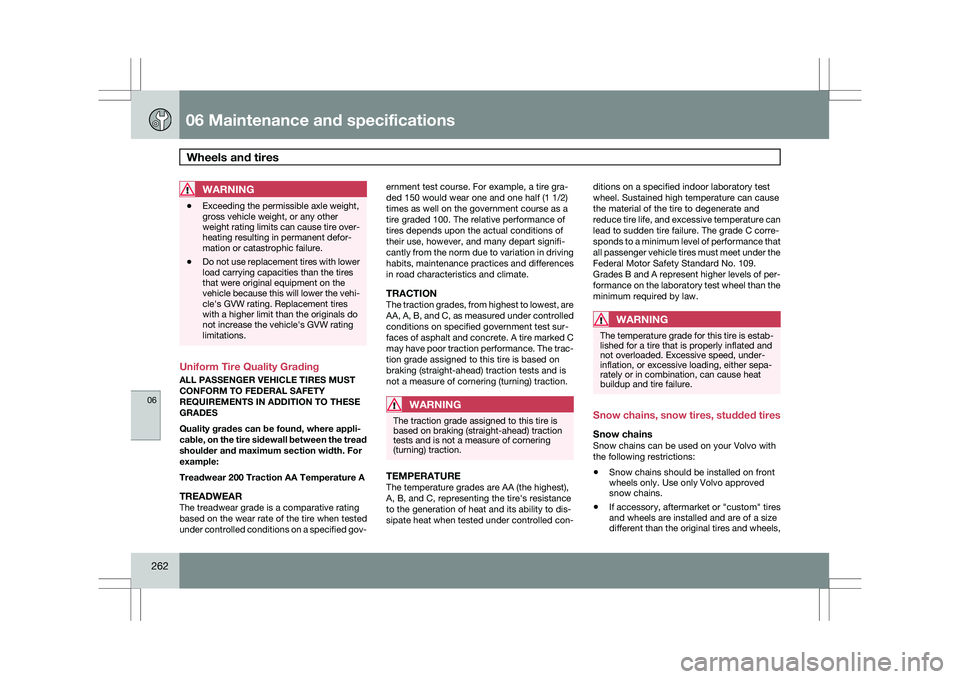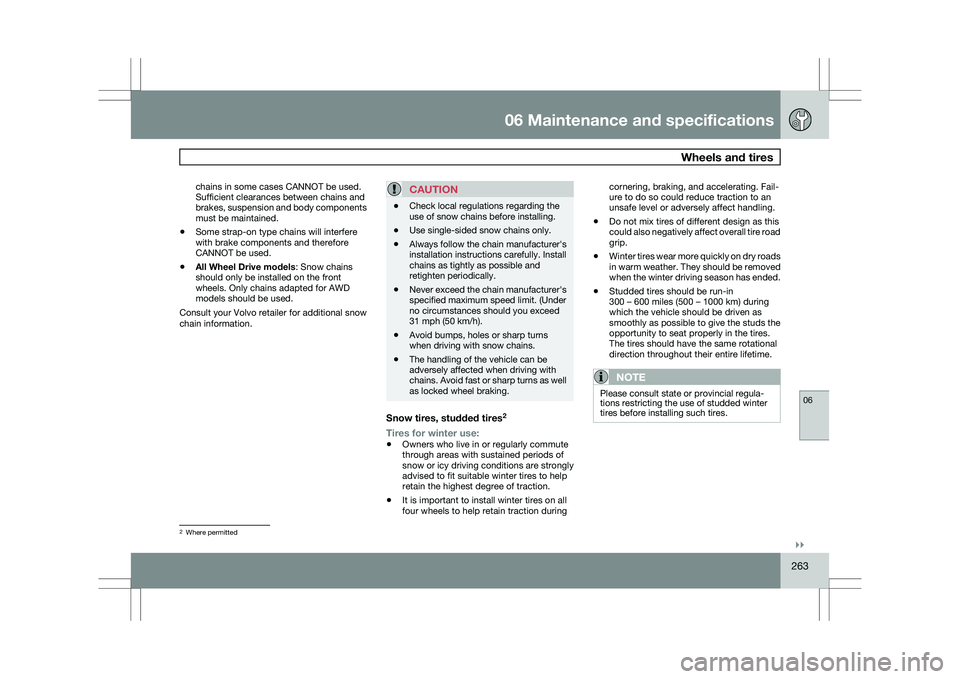2009 VOLVO XC60 snow chains
[x] Cancel search: snow chainsPage 157 of 297

04 Comfort and driving pleasure
Stability system04
}}
155
Introduction
The Dynamic Stability and Traction Control
system (DSTC) consists of a number of func-
tions designed help reduce wheel spin, coun-
teract skidding, and to generally help improve
directional stability.
CAUTION
A pulsating sound will be audible when the
system is actively operating and is normal.
Traction control (TC)This function is designed to help reduce wheel
spin by transferring power from a drive wheel
that begins to lose traction to the wheel on the
opposite side of the vehicle (on the same axle).
TC is most active at low speeds.
This is one of DSTC\fs permanent functions and
cannot be switched off.
Active Yaw Control (AYC)This function helps maintain directional stabil-
ity, for example when cornering, by braking
one or more of the wheels if the vehicle shows
a tendency to skid or slide laterally.
This is one of DSTC\fs permanent functions and
cannot be switched off.
Spin control (SC)The spin control function is designed to help
prevent the drive wheels from spinning while
the vehicle is accelerating.
Under certain circumstances, such as when
driving with snow chains, or driving in deep
snow or loose sand, it may be advisable to
temporarily switch off this function for maxi-
mum tractive force.
WARNING
The car\fs handling and stability characteris-
tics will be altered if the spin control function
has been disabled.
Operation
Temporarily switching off Spin control1.
Turn the thumbwheel until the DSTC
menu is shown.
2. Hold down the RESET button to toggle
between DSTC SPIN CONTROL ON or
OFF.
Messages in the information display
DSTC Temporarily OFF – system function
has been temporarily reduced due to high
brake disc temperature. The function is acti-
vated automatically when the brakes have
cooled.
DSTC Service required – the system has
been disabled due to a fault. If this occurs:
1. Stop the vehicle in a safe place and turn off
the engine.
2. Restart the engine.
If the message remains when the engine is
restarted, drive to an authorized Volvo work-
shop to have the system inspected.
Symbols in the instrument panel
If the symbols and are dis-
played at the same time, read the message in
the information display. G02140
9
Page 264 of 297

06 Maintenance and specificationsWheels and tires 06
262
WARNING \b
Exceeding the permissible axle weight,
gross vehicle weight, or any other
weight rating limits can cause tire over-
heating resulting in permanent defor-
mation or catastrophic failure.
\b Do not use replacement tires with lower
load carrying capacities than the tires
that were original equipment on the
vehicle because this will lower the vehi-
cle\fs GVW rating. Replacement tires
with a higher limit than the originals do
not increase the vehicle\fs GVW rating
limitations. Uniform Tire Quality Grading
ALL PASSENGER VEHICLE TIRES MUST
CONFORM TO FEDERAL SAFETY
REQUIREMENTS IN ADDITION TO THESE
GRADES
Quality grades can be found, where appli-
cable, on the tire sidewall between the tread
shoulder and maximum section width. For
example:
Treadwear 200 Traction AA Temperature A
TREADWEARThe treadwear grade is a comparative rating
based on the wear rate of the tire when tested
under controlled conditions on a specified gov- ernment test course. For example, a tire gra-
ded 150 would wear one and one half (1 1/2)
times as well on the government course as a
tire graded 100. The relative performance of
tires depends upon the actual conditions of
their use, however, and many depart signifi-
cantly from the norm due to variation in driving
habits, maintenance practices and differences
in road characteristics and climate.
TRACTIONThe traction grades, from highest to lowest, are
AA, A, B, and C, as measured under controlled
conditions on specified government test sur-
faces of asphalt and concrete. A tire marked C
may have poor traction performance. The trac-
tion grade assigned to this tire is based on
braking (straight-ahead) traction tests and is
not a measure of cornering (turning) traction.
WARNING
The traction grade assigned to this tire is
based on braking (straight-ahead) traction
tests and is not a measure of cornering
(turning) traction.
TEMPERATUREThe temperature grades are AA (the highest),
A, B, and C, representing the tire\fs resistance
to the generation of heat and its ability to dis-
sipate heat when tested under controlled con-ditions on a specified indoor laboratory test
wheel. Sustained high temperature can cause
the material of the tire to degenerate and
reduce tire life, and excessive temperature can
lead to sudden tire failure. The grade C corre-
sponds to a minimum level of performance that
all passenger vehicle tires must meet under the
Federal Motor Safety Standard No. 109.
Grades B and A represent higher levels of per-
formance on the laboratory test wheel than the
minimum required by law.
WARNING
The temperature grade for this tire is estab-
lished for a tire that is properly inflated and
not overloaded. Excessive speed, under-
inflation, or excessive loading, either sepa-
rately or in combination, can cause heat
buildup and tire failure.
Snow chains, snow tires, studded tires
Snow chainsSnow chains can be used on your Volvo with
the following restrictions:
\b
Snow chains should be installed on front
wheels only. Use only Volvo approved
snow chains.
\b If accessory, aftermarket or "custom" tires
and wheels are installed and are of a size
different than the original tires and wheels,
Page 265 of 297

06 Maintenance and specifications
Wheels and tires06
}}
263
chains in some cases CANNOT be used.
Sufficient clearances between chains and
brakes, suspension and body components
must be maintained.
\b Some strap-on type chains will interfere
with brake components and therefore
CANNOT be used.
\b All Wheel Drive models: Snow chains
should only be installed on the front
wheels. Only chains adapted for AWD
models should be used.
Consult your Volvo retailer for additional snow
chain information.
CAUTION \b
Check local regulations regarding the
use of snow chains before installing.
\b Use single-sided snow chains only.
\b Always follow the chain manufacturer\fs
installation instructions carefully. Install
chains as tightly as possible and
retighten periodically.
\b Never exceed the chain manufacturer\fs
specified maximum speed limit. (Under
no circumstances should you exceed
31 mph (50 km/h).
\b Avoid bumps, holes or sharp turns
when driving with snow chains.
\b The handling of the vehicle can be
adversely affected when driving with
chains. Avoid fast or sharp turns as well
as locked wheel braking.
Snow tires, studded tires 2
Tires for winter use:
\b Owners who live in or regularly commute
through areas with sustained periods of
snow or icy driving conditions are strongly
advised to fit suitable winter tires to help
retain the highest degree of traction.
\b It is important to install winter tires on all
four wheels to help retain traction during cornering, braking, and accelerating. Fail-
ure to do so could reduce traction to an
unsafe level or adversely affect handling.
\b Do not mix tires of different design as this
could also negatively affect overall tire road
grip.
\b Winter tires wear more quickly on dry roads
in warm weather. They should be removed
when the winter driving season has ended.
\b Studded tires should be run-in
300 – 600 miles (500 – 1000 km) during
which the vehicle should be driven as
smoothly as possible to give the studs the
opportunity to seat properly in the tires.
The tires should have the same rotational
direction throughout their entire lifetime.
NOTE Please consult state or provincial regula-
tions restricting the use of studded winter
tires before installing such tires.
2
Where permitted
Page 295 of 297

07 Index07
293
R
Radio
Sirius satellite radio ............141, 143, 144
Radio functions ........................................ 138
Digital Audio Broadcasting (DAB) .......140
HD digital radio ................................... 139
Rain sensor ................................................ 93
READ button............................................ 123
Rear fog light ..................................... 89, 236
Rear park assist............................... 187, 189
Rear seats center head restraint.............................
84
folding ................................................... 83
heated................................................. 129
Rearview mirror auto-dim function ................................. 99
compass............................................. 154
Rear window defroster.............................. 99
Recalls, child restraints ..............................44
Refrigerant ............................................... 285
Refueling .......................................... 206, 207
fuel filler cap....................................... 208
fuel filler door ...................................... 208
fuel tank volume ................................. 285Registering child restraints
........................44
Remote control .......................................... 50
approach lighting .................................. 52
common functions ................................ 52
immobilizer ........................................... 50
key blade........................................ 50, 55
key memory.......................................... 50
locking the vehicle ................................ 52
Personal Car Communicator ..........52, 53
replacing the battery .............................56
unlocking the vehicle ............................52
Reporting safety defects............................
13
Roadside Assistance ............................... 287
Rollover Protection System (ROPS) ..........31
Roll Stability Control (RSC) ........................31
Roof loads................................................ 211
S Safety, occupant........................................ 12
Safety defects, reporting...........................
13
Seat belt reminder................................................
15Seat belts
Automatic locking retractor/Emergency
locking retractor
.................................... 34
buckling ................................................ 14
maintenance ......................................... 14
pretensioners ........................................ 14
reminder................................................ 14
reminder warning light ..........................76
securing child restraint sys-
tems.......................................... 37, 39, 41
unbuckling ............................................ 14
use during pregnancy ...........................16
using ..................................................... 14
Seats, front................................................ 81
Side door mirrors....................................... 98
Side impact airbags................................... 26
Side marker lights, changing bulbs .........235
Sirius satellite radio.................. 141, 143, 144
Snow chains ............................................ 262
Snow tires................................................ 262
Sound settings, audio system .................136
Spare tire................................................. 264
Speed-dependent steering...................... 157
Spin control ............................................. 155
SRS............................................................ 17